Dubrovnik, Croatia’s most iconic coastal city, is a living museum of medieval walls, sun-drenched stone streets, and Adriatic charm. Dubrovnik’s UNESCO-listed Old Town, 2 km long medieval city walls, lovely pebbly beaches, small islands in the vicinity, Game of Thrones filming locations, and wine-growing Konavle valley, make it one of the most visited places in Croatia.
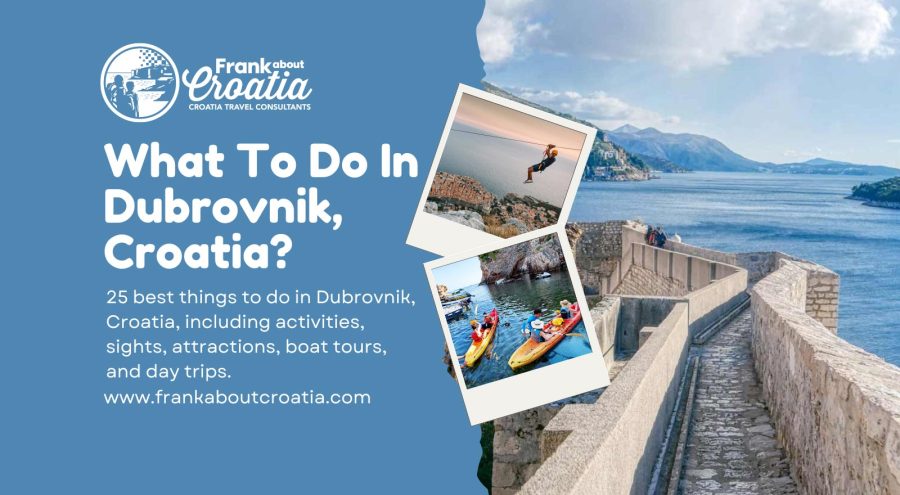
The city’s top attractions include walking the medieval city walls, exploring Baroque churches and palaces, and sailing to nearby islands like Lokrum and the Elaphiti archipelago. Outdoor enthusiasts enjoy activities such as kayaking around historic fortresses, ziplining above the Adriatic Sea, or hiking through scenic coastal trails. Local beaches like Banje and secluded bays promise relaxation, while vibrant cafés, seafood tavernas, and cliffside bars offer unforgettable sunset views.
Whether you’re a Game of Thrones fan tracing filming locations, a foodie tasting Dalmatian delicacies, or a day-tripper heading to Montenegro or Mostar, Dubrovnik delivers unforgettable experiences for all travelers. This guide explores the 25 best activities, attractions, and day trips in and around Dubrovnik!
What's Inside
25 Best things to do in Dubrovnik
Once a proud maritime republic, Dubrovnik offers visitors a unique blend of history, culture, and nature, set against the shimmering backdrop of the Dalmatian coast. From its historic Old Town to panoramic viewpoints atop Mount Srđ, every corner of Dubrovnik reveals a story worth discovering. It’s a perfect place to visit either for a day or longer.
In this post, we share the best things to do in Dubrovnik, including top activities, day tours, and attractions.
The Most Popular Activities and Day Tours in Dubrovnik
1. Walk the City Walls

Walking Dubrovnik’s city walls is the ultimate way to experience the city’s historical grandeur. Encircling the Old Town for nearly 2 kilometers, these impressive medieval fortifications date back to the 13th century and offer sweeping views of terracotta rooftops, the shimmering Adriatic Sea, and nearby Lokrum Island. The walk takes about 1.5 to 2 hours and is dotted with 16 towers, 6 bastions, 3 fortresses, and dramatic lookout points. It’s best done in the early morning or late afternoon to avoid crowds and heat. Don’t forget your camera: every corner offers a postcard-perfect scene.
Once you climb atop the walls, walking along them isn’t too difficult, especially during the first part until you reach St. Luke’s Tower. However, after St. Luke’s Tower, the climb becomes more challenging, particularly the section from Revelin to Minceta Tower. This is why many tour groups conclude their visit at St. Luke’s Tower, which also serves as an auxiliary entrance and exit to the town walls.
We encourage you to complete the entire circuit of the city walls at your own pace. Take your time, as the views from the other side are spectacular. If you have extra energy, consider climbing to the top of Minceta Tower, the highest point of the Dubrovnik old town walls.
Adult tickets cost around €40, and children under 18 years of age pay €15. The walls are typically open year-round (except December 25) with hours varying by season; for example, 08:00 am to 7:30 pm in summer (July) and shorter hours in winter.
Working hours for Dubrovnik city walls | Jan, Feb: 10 am-3 pm | March, Nov, Dec: 9 am-3 pm | Apr, May: 9 am-6 pm | June, July: 8 am-7.30 pm | August, 15 Sept: 8 am-7 pm | 15 Sept, Oct: 9 am-6 pm
2. Explore the Old Town

Dubrovnik’s Old Town is a living museum, where every cobblestone street and centuries-old building tells a story. Built entirely of white stones, polished with age, it abounds in Gothic, Renaissance, and Baroque palaces, churches, and monasteries.
The main promenade, Stradun, is the heartbeat of the city, lined with historic buildings, lively cafes, and local shops. Notable landmarks include the Rector’s Palace, Sponza Palace, the Church of St. Blaise, and the Franciscan Monastery, which houses one of the oldest working pharmacies in Europe.
Must-see landmarks in Dubrovnik Old Town are listed below.
Must-See Landmarks in Dubrovnik Old Town

- City Walls
Encircling the entire Old Town for nearly 2 km, the medieval walls date back to the 13th century and are Dubrovnik’s most iconic attraction. Featuring 16 towers, 6 bastions, and 3 fortresses, they offer panoramic views of the Adriatic, Lokrum Island, and the city’s rooftops. A full circuit takes 1.5–2 hours. - Stradun (Placa Street)
The polished limestone promenade that forms the central artery of the Old Town, lined with cafes, shops, and 17th-century buildings. - Rector’s Palace
A former seat of the Republic’s ruler, this elegant Gothic-Renaissance palace now houses the Cultural History Museum with original artifacts. - Sponza Palace
A 16th-century Gothic-Renaissance building that once served as a customs house and mint, now home to the city’s historical archives. - Church of St. Blaise
A richly decorated Baroque church dedicated to Dubrovnik’s patron saint, featuring a beloved statue of St. Blaise holding a model of the city. - Franciscan Monastery & Old Pharmacy
Home to one of Europe’s oldest pharmacies (since 1317) and a peaceful cloister, with a small museum of ancient manuscripts and medical tools. - Dominican Monastery
A tranquil complex housing religious art, valuable manuscripts, and a beautiful cloister with early-Gothic elements. - Jesuit Stairs and Jesuit Church of St. Ignatius
The dramatic staircase, often compared to the Spanish Steps, leads up to the Baroque Jesuit Church, famous as a filming location in Game of Thrones. - Onofrio’s Large and Small Fountains
Two ornate 15th-century fountains that once supplied the entire city with water via a 12 km aqueduct system is today popular spots to cool off and rest. - Dubrovnik Cathedral (Assumption Cathedral)
A Baroque cathedral, rebuilt after the 1667 earthquake, with an impressive altar, treasury of relics, and artwork, including a polyptych by Titian. - Clock Tower
Located at Luža Square, this 31-meter high bell tower built in the 15th century stands as one of Dubrovnik’s symbolic structures, chiming hourly since medieval times. - Orlando’s Column
A medieval symbol of independence and freedom, standing in front of St. Blaise’s Church and used historically for public proclamations. - Pile Gate
The grand western entrance into the city, featuring a stone bridge and a statue of St. Blaise above the arch. - Ploče Gate
The eastern entrance to the Old Town, often less crowded and offering access to Fort Revelin and Banje Beach. - Old Harbour (Porat)
Once the commercial heart of Dubrovnik’s maritime republic, now a scenic marina offering boat tours and ferry departures to Lokrum Island. - Fort Lovrijenac
Often called the “Gibraltar of Dubrovnik,” this imposing cliffside fortress stands just outside the western walls. Built in the 11th century to defend the city from both land and sea, it offers spectacular views of the Adriatic and is a key Game of Thrones filming location (Red Keep). It’s also used as a venue during the Dubrovnik Summer Festival.
You can explore Dubrovnik Old Town on your own or you book a guided Dubrovnik city tour.
There is also a private guided tour if you want to learn more about the town. Find the latest prices and full itinerary here.
City Walls
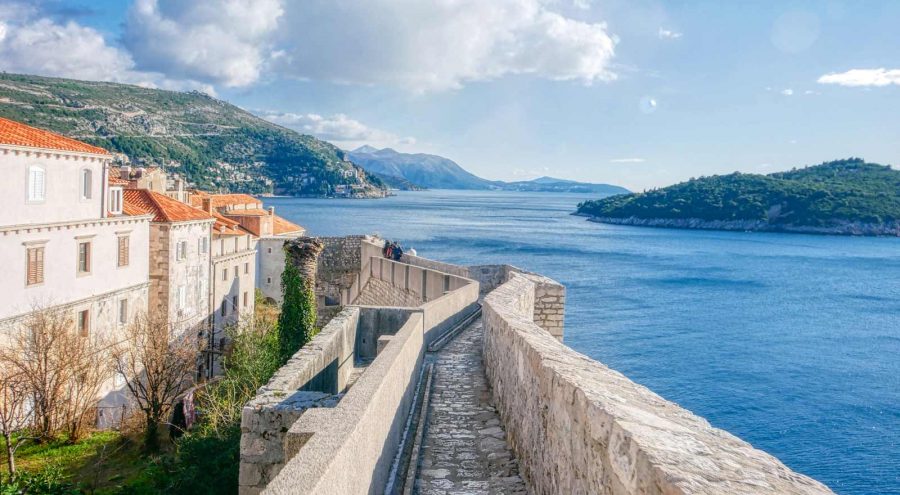
Dubrovnik’s City Walls are among the finest examples of medieval fortification in Europe, standing as a symbol of the city’s independence and resilience. Originally begun in the 9th century and extensively developed from the 13th to 17th centuries, the walls were built to protect the Republic of Ragusa, an influential maritime power, from land and sea attacks.
Encircling the entire Old Town, the walls stretch nearly 2 kilometers, with some sections reaching up to 25 meters in height and 6 meters in thickness on the landward side. The system includes 16 towers, 6 bastions, 2 corner fortifications, and 3 major forts: Minčeta Tower, the highest point and a key lookout; Fort Bokar, guarding the western approach; and Fort St. John, defending the harbor.
Beyond their scale and strength, the walls reflect the advanced military engineering of their time. They were continuously upgraded to adapt to evolving threats and were never breached by an enemy force—a testament to their strategic brilliance and the defensive foresight of Dubrovnik’s leadership.
Stradun Street
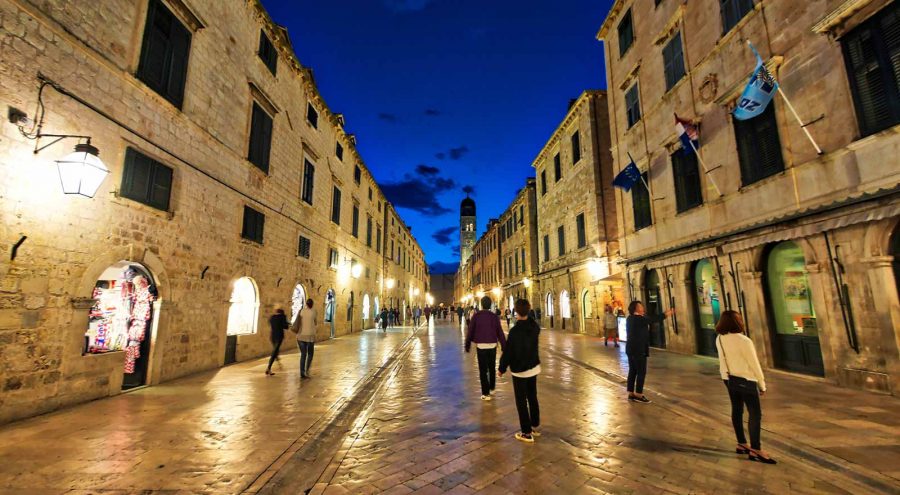

Stradun, also known by locals as Placa, is the main street of Dubrovnik’s Old Town and its most vibrant public space. Paved with smooth limestone and stretching nearly 300 meters, it is not only the longest but also the widest street within the city walls.
This elegant promenade connects two major landmarks: Onofrio’s Fountain near Pile Gate at the western entrance, and Orlando’s Column beside Sponza Palace on the eastern end. Along the way, Stradun passes some of Dubrovnik’s most iconic attractions, including the Franciscan Monastery, Church of St. Saviour, and the world’s third-oldest operating pharmacy on one end, and St. Blaise’s Church, Rector’s Palace, and Sponza Palace on the other.
Lined with uniform Baroque buildings, the street owes its symmetrical appearance to the careful urban reconstruction following the devastating 1667 earthquake, when much of the city was rebuilt in a harmonious architectural style.
Today, Stradun serves as Dubrovnik’s main promenade, bustling with cafes, shops, restaurants, and bars. It’s also the stage for major public events and celebrations, including the Feast of St. Blaise, New Year’s Eve, and summer festivals.
For a quirky local tradition, try balancing on the small mascaron ornament embedded in the wall of the Franciscan Monastery. Once used as a water spout, it’s now believed to bring good luck to anyone who can climb and stand on it without falling, an enduring Stradun ritual for visitors and locals alike.
Rector’s Palace

The Rector’s Palace was once the political and administrative heart of the Republic of Ragusa, serving as the official residence of the Rector—the elected head of state who governed for a term of just one month. More than just a home, the palace also housed a courtroom, council chambers, administrative offices, a prison, an arsenal, and even gunpowder storage—the latter of which led to two devastating explosions in 1435 and 1463.
Above the main entrance, an inscription still echoes the civic spirit of the Republic: “Obliti Privatorum Publica Curate”—translated as “Forget private affairs, care for public ones.”
The building is primarily Gothic in style, but following damage from fires, explosions, and the 1667 earthquake, it was rebuilt with Renaissance and Baroque elements, resulting in a unique architectural blend. Its elegant inner courtyard, adorned with a sculpted staircase and delicate columns, is especially photogenic and often hosts chamber music concerts in the summer.
Today, the palace is home to the Cultural-Historical Museum, showcasing period furnishings, artworks, and artifacts from the Republic period, including ceremonial objects, coins, and archival documents, a compelling immersion into Dubrovnik’s storied past.
Since 9 AM to 6 PM daily (closing at 4 PM in winter), the palace welcomes visitors with a €15 adult ticket (€6 for children). The Dubrovnik Pass (formerly Dubrovnik Card) includes free entry, making it a smart addition for museum-goers
Sponza Palace

Located at the eastern end of Stradun on Luža Square, Sponza Palace was constructed in 1520, and it originally served as a customs house and financial center for the Republic of Ragusa. Today, it houses Dubrovnik’s State Archives, preserving some of the city’s most important historical documents, including records dating back to the 12th century.
The palace is a stunning example of Gothic-Renaissance architecture, with its arcaded courtyard, ornate columns, and symmetrical design. Above the main entrance, an inscription reflects the city’s commitment to honest commerce: “Fallere nostra vetant et falli pondera. Meque pondero cum merces, ponderat ipse Deus”
(“Our weights forbid cheating and being cheated. As I measure goods, God measures with me.”)
Remarkably, Sponza Palace is one of the few major buildings to survive the devastating 1667 earthquake intact.
Today, the palace hosts various temporary exhibitions, and also features a memorial room dedicated to the defenders of Dubrovnik who lost their lives during the Croatian Homeland War (1991–1995).
Atrium and memorial room are free to enter, while state archives aren’t available to public.
Church of St. Blaise

Located on Luža Square, the Church of St. Blaise is one of Dubrovnik’s most beloved landmarks and a masterpiece of Baroque architecture. Built in 1715 by Venetian architect Marino Gropelli, it replaced an older Romanesque church destroyed by fire.
Dedicated to Dubrovnik’s patron saint, the church features a striking façade with statues of St. Blaise holding a model of the city. Inside, its highlight is a 15th-century silver statue of the saint—rescued from the fire—alongside richly decorated altars and stained-glass windows.
St. Blaise’s feast day on February 3 is a major local celebration, drawing thousands to honor the city’s protector.
Entry is free, and the church is open daily to visitors and worshippers alike.
Franciscan Monastery And Old Pharmacy

Located just off Stradun, the Franciscan Monastery appears modest from the outside, but it houses some of the most remarkable cultural treasures in Dubrovnik. This 14th-century complex is known for its serene Romanesque cloister, historic pharmacy, and a vast library.
The cloister, built in 1360, features 120 ornately carved columns and surrounds the oldest garden in Dubrovnik, offering a tranquil retreat from the bustle of the Old Town. The monastery’s pharmacy, in continuous operation since 1317, is one of the oldest functioning pharmacies in the world and still serves customers today. It also displays antique medical tools, laboratory equipment, and original recipes.
The monastic library is another highlight, with a collection of over 75,000 works, including 20,000 books, 10,000 musical scores, and numerous rare manuscripts and incunabula.
Admission is €6 ($7), and entry is free with the Dubrovnik Pass. Opening hours are from 9 am to 6 pm daily (in winter until 4 pm).
Dominican Monastery

Integrated into Dubrovnik’s eastern walls, the Dominican Monastery blends seamlessly with the city’s fortifications, reflecting its role as both a place of worship and a line of defense. Established in 1225 and built in the 14th century, it is known for its peaceful Gothic cloister, a historic library, and an impressive art museum.
The library preserves rare manuscripts, including the city’s oldest book catalog (Cupientes emere libros, 1480) and writings by Thomas Aquinas. The museum showcases artworks by Titian, Paolo Veneziano, and other Renaissance masters.
A unique local detail: the enclosed staircase to the western entrance was designed to shield women’s ankles from view as they climbed to church—a reflection of past social norms.
Admission: €6 ($7) | Working hours: 9 am- 6 pm (4 pm in winter)
Jesuit Stairs and Jesuit Church of St. Ignatius
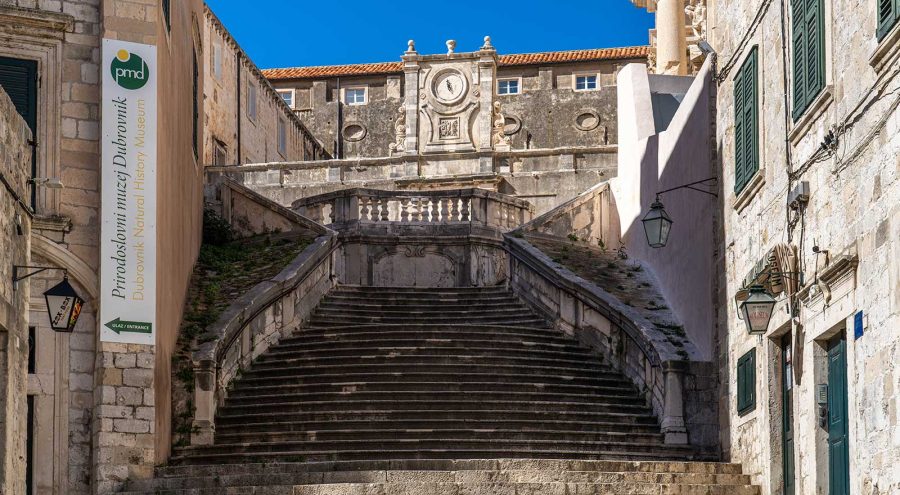
Often compared to the Spanish Steps in Rome, the Jesuit Stairs are one of Dubrovnik’s most visually striking features. Built in the 1730s by Roman architect Pietro Passalacqua, the grand Baroque staircase links Gundulić Square to Rupe Street, leading up to the Church of St. Ignatius and the adjoining Jesuit College.
The Church of St. Ignatius, completed in 1725, is a masterpiece of Baroque architecture inspired by the mother church of the Jesuit order in Rome. Its richly decorated interior features frescoes by Gaetano Garcia, depicting scenes from the life of St. Ignatius of Loyola. The church is known for its elegant façade, beautiful altar, and serene atmosphere.
Today, both the stairs and the church are iconic parts of Dubrovnik’s Old Town, popular with photographers and fans of Game of Thrones, which filmed scenes here as the “Walk of Shame” staircase.
Onorfio’s Large And Small Fountains
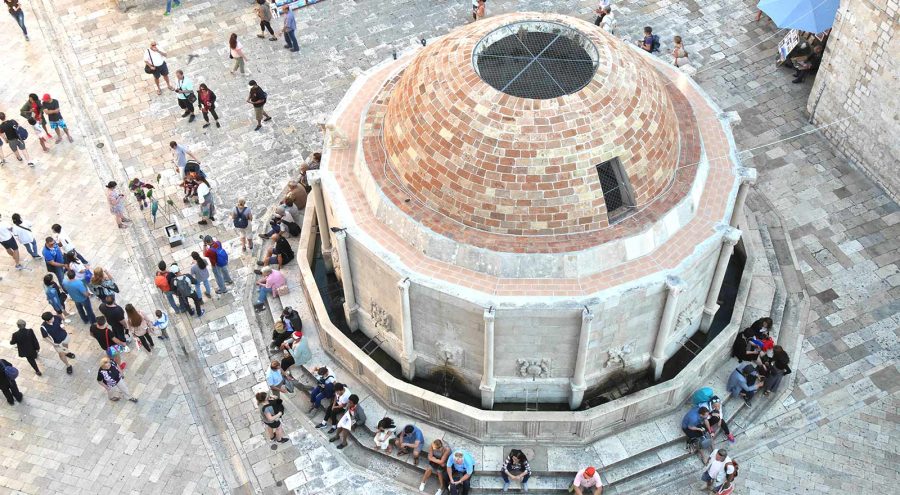
Built in the 15th century, Onofrio’s Fountains were part of Dubrovnik’s advanced water supply system, designed by the Neapolitan engineer Onofrio della Cava. They mark the endpoints of a 12-kilometer aqueduct that brought fresh water from the Dubrovnik hinterland into the walled city.
The Large Onofrio Fountain, located near Pile Gate, is a grand circular structure with sixteen carved stone masks, or mascarons, each spouting water. It served as a public water source and a key social gathering point for centuries.
The Small Onofrio Fountain sits at the opposite end of Stradun, near St. Blaise’s Church, and supplied water to the nearby market and the Rector’s Palace.
Dubrovnik Cathedral of the Assumption of the Blessed Virgin Mary
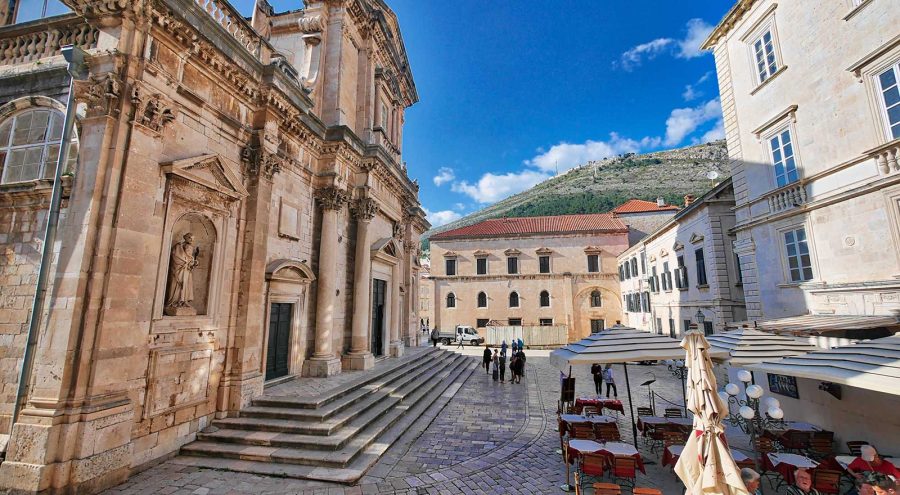
Dominating the skyline of the Old Town, the Dubrovnik Cathedral is a striking Baroque church built in the early 18th century, following the destruction of its Romanesque predecessor in the 1667 earthquake. According to tradition, the original cathedral was financed in part by England’s King Richard the Lionheart, who was shipwrecked near Dubrovnik in 1192.
The current cathedral was designed by Italian architect Andrea Buffalini and completed in 1713. Its bright, spacious interior features a grand dome, richly decorated altars, and important artworks—including a polyptych by Titian above the main altar.
One of the cathedral’s most treasured elements is its treasury, which houses over 200 relics, including the gold-plated skull, arms, and leg of St. Blaise, Dubrovnik’s patron saint.
Located just behind the Rector’s Palace, the cathedral is open to visitors daily, with free entry to the main nave and a small fee to access the treasury.
Dubrovnik Clock Tower
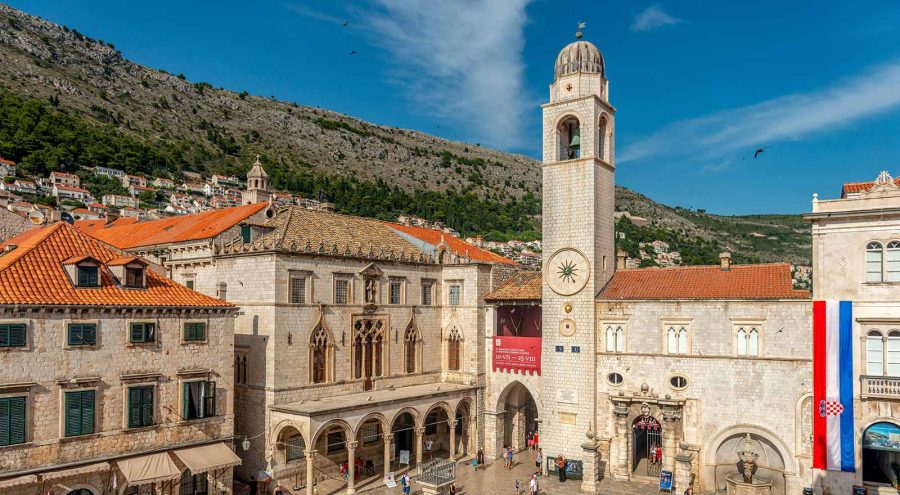
Standing tall at the eastern end of Stradun, near Luža Square, the Dubrovnik Clock Tower is one of the city’s most iconic landmarks. Originally built in 1444, the tower rises 31 meters above the city.
The clock mechanism features two bronze figures, affectionately known as the “Green Men” or Maro and Baro, who strike the bell at the top of each hour. Though the tower has undergone several restorations, including after earthquake damage and structural wear, it retains its historic character and function.
Flanked by Sponza Palace and St. Blaise’s Church, the Clock Tower anchors the city’s central square.
Orlando’s Column

Located in Luža Square, just in front of St. Blaise’s Church, Orlando’s Column, erected in 1418, is one of Dubrovnik’s most enduring symbols. The stone statue depicts the medieval knight Orlando (or Roland).
More than just a decorative monument, the column historically served as a public podium, a place for proclamations, and even as a punishment post for criminals. Orlando’s forearm, measuring 51.2 cm, was used as the official unit of length in the Republic, known as the “Dubrovnik cubit.”
The column remains a gathering point during various events, most notably during the Feast of St. Blaise, when the saint’s flag is hoisted on the tall mast beside it.
Pile Gate
Pile Gate is the main entrance to Dubrovnik’s Old Town and one of the city’s most recognizable landmarks. Built in the 15th century, this heavily fortified gateway was part of the city’s elaborate defensive system and still impresses visitors today with its imposing stone walls, drawbridge, and Gothic archway.
The gate consists of two parts: an outer gate, added in the 16th century and topped with a Renaissance arch, and an inner gate, featuring a carved statue of St. Blaise, the city’s patron saint. Originally protected by a wooden drawbridge and a moat, now a garden, Pile Gate served as the first line of defense against invaders and controlled all access to the walled city.
Today, it remains the busiest pedestrian entrance to the Old Town, connecting directly to Stradun and welcoming thousands of visitors daily.
Ploce Gate
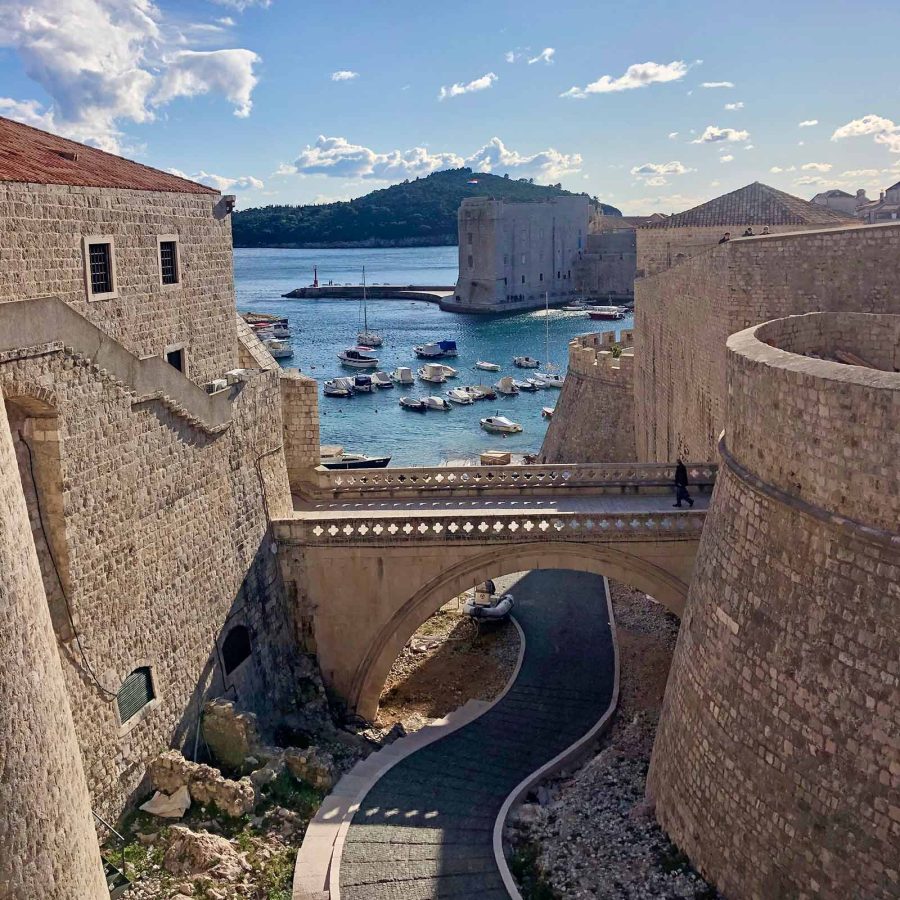
Located at the opposite end of Stradun from Pile Gate, Ploče Gate serves as the eastern entrance to Dubrovnik’s Old Town and a key point of access for visitors arriving from the modern city or nearby attractions like Banje Beach and Fort Revelin.
Built in the 14th century, the gate consists of an inner and outer section, connected by a stone bridge over what was once a defensive moat. Like Pile Gate, it is topped with a statue of St. Blaise, symbolizing protection and civic identity.
While smaller and less crowded than Pile Gate, Ploče Gate was no less strategic, controlling eastern land access to the city and reinforcing Dubrovnik’s layered defense system. Today, it offers a more tranquil entry point and direct access to the eastern side of the city walls.
Old Harbour (Porat)

Located at the eastern edge of the Old Town, just below St. John’s Fortress, Dubrovnik’s Old Harbour, known locally as Porat, was once the bustling heart of the city’s maritime trade. During the days of the Republic of Ragusa, it served as a main entryway for merchants, sailors, and diplomats arriving from across the Adriatic and Mediterranean.
Protected by massive stone breakwaters and fortified by Fort St. John and Fort Revelin, the harbor played commercial and defensive roles. Today, it’s a serene waterfront space lined with boats, cafes, and scenic views of Lokrum Island.
Visitors can stroll along the historic piers, watch fishermen at work, or catch ferries to nearby islands like Lokrum and the Elaphiti Islands. The Old Harbour remains a vibrant part of Dubrovnik’s heritage and a favorite spot for photography, dining, and coastal relaxation.
Fort Lovrjenac
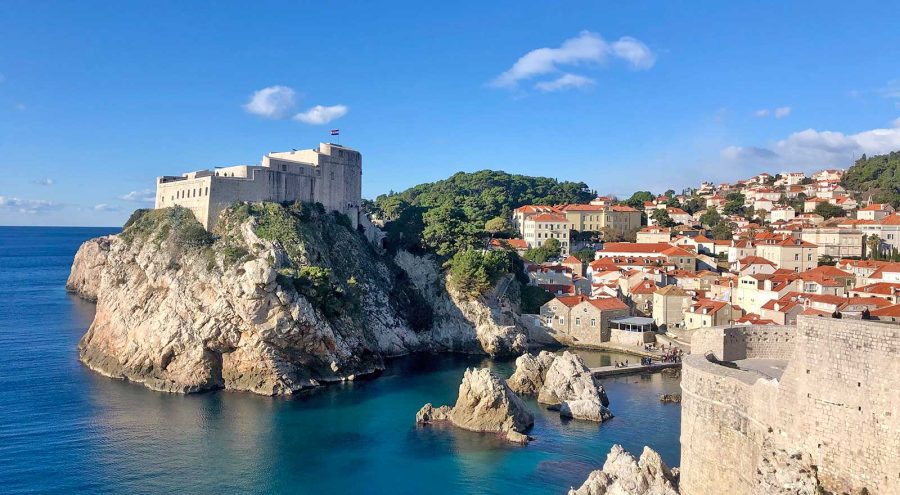
Rising dramatically on a 37-meter-high cliff just outside Dubrovnik’s western walls, Fort Lovrijenac was a important part of the city’s defense against land and sea attacks. Built in the early 11th century, the fort played a critical role in protecting Dubrovnik’s freedom, especially from Venetian ambitions.
Its triangular structure features thick walls up to 12 meters on the side facing the sea, and thinner walls on the city-facing side. Above its entrance, an inscription reads: “Non bene pro toto libertas venditur auro” (“Freedom is not to be sold for all the gold in the world”).
Today, Fort Lovrijenac is open to visitors and offers stunning panoramic views of the Adriatic Sea and Old Town walls. It’s also a famous Game of Thrones filming location (the Red Keep) and a venue for the Dubrovnik Summer Festival, known for its atmospheric Shakespeare performances.
The ticket costs €15, but the entry is free with either a City Walls ticket or the Dubrovnik Pass.
Working hours for Dubrovnik city walls | Jan, Feb: 10 am-3 pm | March, Nov, Dec: 9 am-3 pm | Apr, May: 9 am-6 pm | June, July: 8 am-7.30 pm | August, 15 Sept: 8 am-7 pm | 15 Sept, Oct: 9 am-6 pm
3. Ride the Cable Car to Mount Srđ
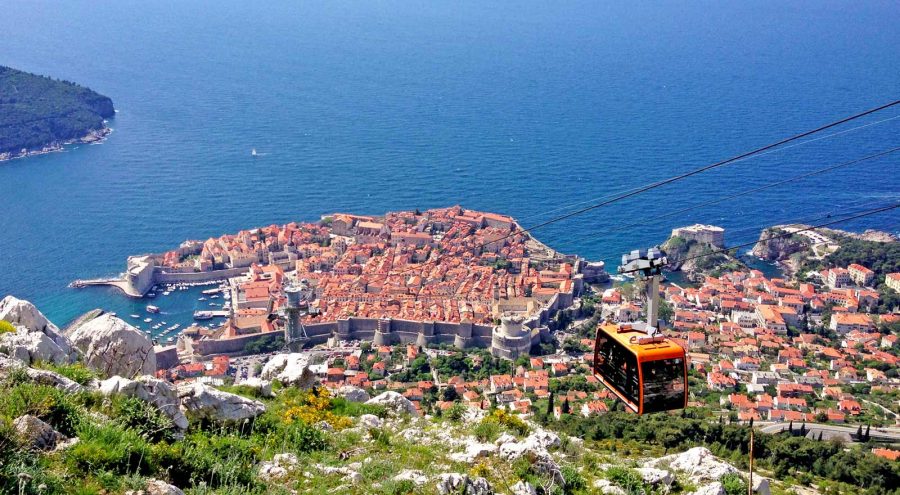
For one of the most spectacular views in all of Croatia, take the cable car up to Mount Srđ. Soaring 412 meters above Dubrovnik, this short ride offers panoramic vistas of the Old Town, the Adriatic coastline, and nearby islands. At the top, you can visit Fort Imperial, a 19th-century fortress that now hosts a museum about Dubrovnik’s role in the Croatian War of Independence. There’s also a scenic restaurant Panorama where you can enjoy a meal or a drink with one of the best views in the region. Visiting during sunset is especially memorable.
A round-trip ticket costs €30 ($35) for adults and €8 ($9.30) for kids (4 to 12 years old). The cable car operates from April to November.
4. Visit Lokrum Island
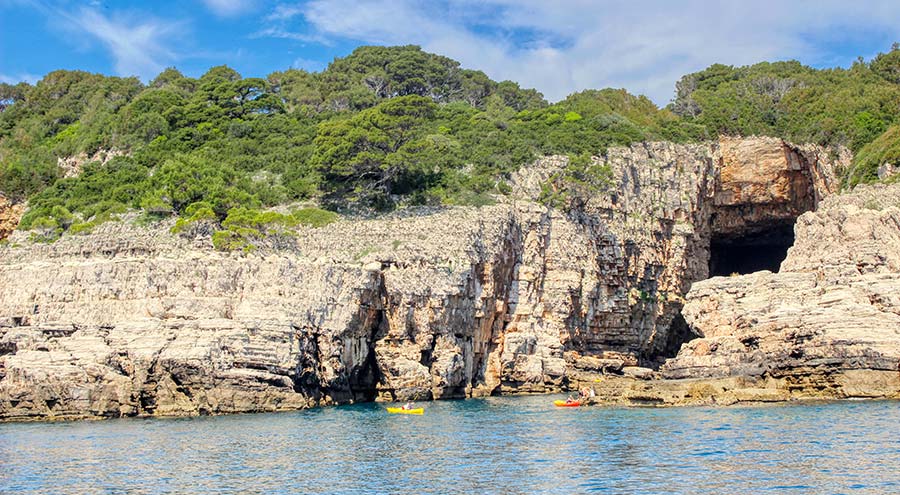
Visiting Lokrum Island is one of the most rewarding half-day trips from Dubrovnik, offering nature, and seaside relaxation just minutes from the Old Town. Located only 600 meters off the coast, Lokrum is a protected nature reserve and a monument of landscape architecture, known for its lush vegetation, quiet beaches, and historical landmarks.
Despite its compact size, Lokrum is the largest park area in Dubrovnik, featuring a peaceful botanical garden, the ruins of a 12th-century Benedictine monastery, and a scenic climb to Fort Royal, which provides panoramic views of the city and sea. Locals and visitors alike head to the island for swimming, sunbathing, and a break from Dubrovnik’s busy streets.
The island is open to the public from April to October and can be reached via a 10-minute boat ride from Dubrovnik’s Old Harbour.
Return ticket costs €27 for adults, and €5 for children (5-18). The ticket is free for children under 5.
5. Relax at Banje Beach
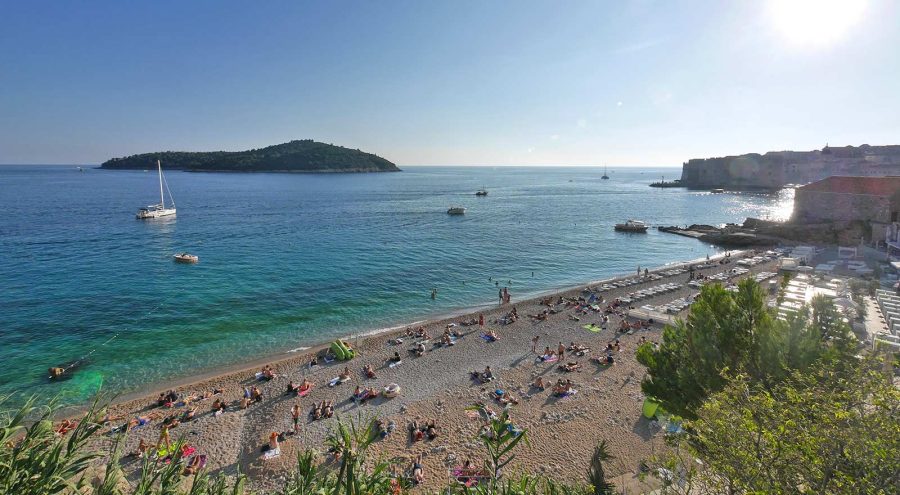
Just a five-minute walk from Ploče Gate, Banje Beach is Dubrovnik’s most accessible and popular beach, offering clear Adriatic waters and views of the Old Town and Lokrum Island.
The beach has essential facilities: sun loungers and umbrellas (around €25/day), changing rooms, showers, and a beachfront restaurant and bar. Visitors can rent kayaks or jet skis, or simply swim and sunbathe.
The beach is free if you bring your own towel. It’s pebbly, so water shoes are recommended. Loungers are optional, but respectful behavior is expected—no loud music or occupying paid spaces without renting.
It’s busiest midday, especially in summer, so visiting early or late in the afternoon is best.
6. Go on a Sea Kayaking Tour Around the City Walls
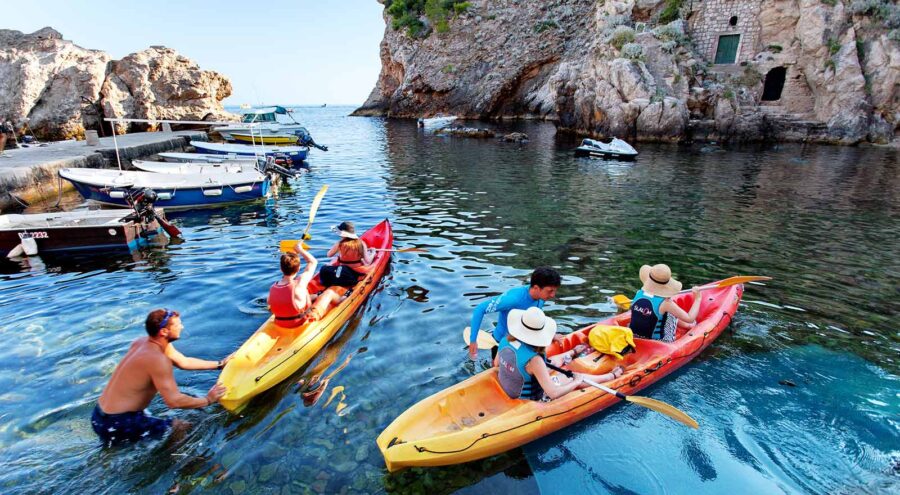
Sea kayaking in Dubrovnik is one of the best ways to experience the city’s historic beauty from a fresh perspective. You haven’t truly seen Dubrovnik until you’ve seen it from the sea. Paddling along the Adriatic coast reveals stunning views of the medieval city walls, hidden coves, and nearby islands.
Routes take you past Banje Beach, Sveti Jakov, and even to the secluded Betina Cave Beach. More adventurous paddlers can cross over to Lokrum Island for a coastal loop. Whether you’re a beginner or experienced kayaker, it’s a flexible and rewarding activity.
You can rent kayaks at beaches like Šulić, Banje, and Sveti Jakov, or join a half-day or sunset guided tour, which often includes snacks and snorkeling.
The half-day guided sea kayaking tour costs approx. €35 ($41, £30) per person.
Top-rated tours include the following.
7. Take an Island Cruise to Elaphiti Islands

A cruise to the Elafiti Islands is one of the best ways to escape the bustle of Dubrovnik and spend a day in nature, enjoying the sea, and local charm. This small archipelago off the coast consists of several islands, but only three are inhabited: Koločep, Lopud, and Šipan.
Each island has its own appeal. Koločep offers shaded pine trails and turquoise coves; Lopud is known for Šunj Beach, one of the few sandy beaches near Dubrovnik; and Šipan, the largest, is perfect for scenic walks, swimming, and discovering quiet stone villages.
The islands are also home to some of the region’s best seaside restaurants. Enjoy fresh seafood at Villa Ruža on Koločep, dine by the water at Obala on Lopud, or indulge in a fine-dining experience at BOWA on Šipan, set in a secluded bay reachable by boat.
The best way to explore the Elafiti is by private speedboat tour, which allows you to island-hop at your own pace. Alternatively, there are great group options like the Elafiti Islands Day Trip with Lunch or the Elafiti Islands Cruise aboard a Karaka ship, which includes scenic sailing and island stops. Prices depend on season and type of cruise, and they range from €50 per person for a group tour to €350 per group of 4 for a private speed boat tour.
You can also reach the islands independently by local ferry from Gruž Port, ideal for a more flexible, budget-friendly adventure.
Whether you’re after beach time, hiking, great food, or just a quiet escape, a day trip to the Elafiti Islands is a perfect addition to your Dubrovnik itinerary.
8. Go On A Sunset Cruise
A sunset cruise in Dubrovnik is one of the most relaxing and visually stunning ways to end your day in the city. As the sun dips behind the horizon, the Old Town’s stone walls and red rooftops glow with golden light, and the Adriatic turns a deep, shimmering blue.
Most cruises depart in the late afternoon from Dubrovnik’s Old Harbour or Gruž Port, and typically last between 1.5 to 2 hours. You can choose between a traditional Karaka ship, modern motor yachts, or smaller sailing boats, depending on your style and budget.
Many tours include a glass of local wine or prosecco, light snacks, and soft music to set the mood. Some even offer optional swimming stops near Lokrum Island or along the coast.
Whether you’re traveling solo, as a couple, or with friends, a sunset cruise offers a peaceful way to take in Dubrovnik’s coastline far from the crowds, with some of the best photo opportunities in the city.
We recommend this Sunset Dinner Cruise around the Old Town.
9. Sample Dalmatian Cuisine
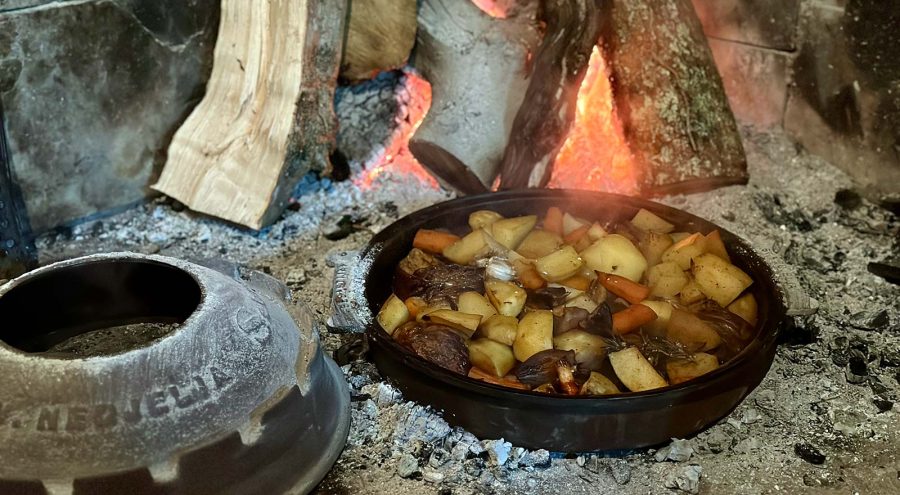
Sampling Dalmatian food in Dubrovnik offers visitors a direct taste of the region’s culinary heritage. Dalmatian cuisine is based on simple, fresh ingredients and traditional cooking methods. From seafood-based dishes like black risotto and octopus salad to inland specialties such as pasticada and slow-cooked peka, the cuisine reflects the diversity of the Dalmatian coast. Visitors to Dubrovnik can explore local flavors at traditional konobas such as Konoba Dubrava and Konoba Pjatanca, both known for their authentic menus and rustic settings. Many restaurants in the Old Town, including Proto and Marco Polo, also serve well-executed versions of these regional dishes.
In addition to dining out, travelers can join guided food tours that highlight local ingredients, street snacks, and regional wines. These tours typically include stops at multiple eateries and food shops, offering a broad overview of Dalmatian flavors. Another option is to join a home-hosted experience, such as those offered by Eat With Locals, where guests can prepare and enjoy meals like peka in a local family’s home.
Food tours in Dubrovnik, as well as cooking classes and home-hosted dinners typically cost about €120 ($140, £103).
10. Visit Fort Lovrijenac

Fort Lovrijenac, perched on a 37-meter-high cliff just outside Dubrovnik’s Old Town near Pile Gate, is a must-visit site for history enthusiasts and cultural travelers. Located within walking distance of the city center, the fortress is easily accessible on foot and forms part of the larger Dubrovnik fortification system. Fort Lovrijenac is famous for its strategic military role in defending the city from Venetian invasion, its panoramic views over the Adriatic Sea, and its appearance as the Red Keep in Game of Thrones.
The fortress features massive stone walls, an inner courtyard, and several tiers of battlements, offering a commanding view of Dubrovnik’s medieval skyline. Visitors can explore historic inscriptions, such as the one above the entrance reading “Non bene pro toto libertas venditur auro” – “Freedom is not to be sold for all the gold in the world,” as well as open cannon bays and a terrace used for cultural events and performances. The upper levels provide one of the best photo vantage points in Dubrovnik, with sweeping views of the city’s red rooftops and the open sea.
Fort Lovrijenac is typically visited alongside the Dubrovnik City Walls, with both attractions included in a single ticket. It is recommended to spend 30 to 45 minutes exploring the fortress. The approach includes a steep staircase, so comfortable walking shoes are advisable. The best times to visit are in the early morning or late afternoon, when the light is ideal for photography and the site is less crowded.
The cost of visiting Fort Lovrijenac is included in the Dubrovnik City Walls ticket, which is priced at €40 ($46, £34) for adults. This ticket grants same-day access to both the fortress and the city walls. Visitors can purchase tickets at either entrance or online. Guided walking tours, including Game of Thrones-themed experiences, often include Fort Lovrijenac and provide additional historical context.
11. Discover Game of Thrones Filming Locations

Dubrovnik, located on Croatia’s southern Adriatic coast, is a must-visit destination for Game of Thrones fans and TV enthusiasts. While the city was already a popular tourist attraction thanks to its medieval architecture and UNESCO-listed Old Town, its global fame soared after it was chosen as the primary filming location for King’s Landing in the HBO series. Scenes were filmed across many iconic locations in and around Dubrovnik, including Fort Lovrijenac (Red Keep), Fort Bokar (city walls of King’s Landing), and Gradac Park (the Purple Wedding). Other notable sites include the Jesuit Stairs, where Cersei’s Walk of Shame began, the Dominican Monastery, Pile Gate, and Pile Harbor, which often appeared in boat departure scenes. The city also stood in for Quarth, with Minceta Tower, Rector’s Palace, and Lokrum Island playing the parts.
Many filming locations are easily accessible by foot within the Old Town. Visitors can explore them independently using online maps or resources, but joining a guided Game of Thrones tour offers a deeper experience. Guides, often former set extras, share behind-the-scenes stories, help recreate key scenes, and point out lesser-known filming spots. Some tours also visit off-site locations such as Trsteno Arboretum (the Red Keep gardens), Lokrum Island (Quarth), and the abandoned Belvedere Hotel, which appeared in Season 4.
The cost of discovering Game of Thrones locations in Dubrovnik depends on the experience you choose. Standard guided walking tours through the Old Town cost approximately €25 ($30, £21) per person and typically last two hours. These tours often include a replica Iron Throne photo opportunity. For fans wanting to explore beyond the city, combination tours, such as the Game of Thrones Tour & Cruise, include stops at Trsteno and Lokrum Island. These extended excursions cost around €40 ($47, £34).
12. Visit Dubrovnik Museums
Visiting Dubrovnik’s museums offers an in-depth look at the city’s complex history, maritime legacy, and local culture. Located throughout the Old Town and surrounding areas, these museums cover a wide range of themes: from traditional life in Dubrovnik to its role in the Republic’s global trading network. The museums appeal to visitors interested in history, architecture, and cultural heritage, and are easily accessible on foot from any part of the Old Town. Each museum is housed in a historic building, adding further depth to the visitor experience.
One of the most notable is the Ethnographic Museum Rupe, located in a former granary tucked away in the Old Town. It displays over 5,000 items related to traditional customs, folk dress, and domestic life. Just steps away is the Gornji Ugao Tower Museum, which preserves a complete 15th-century cannon foundry. The site covers 600 square meters and offers guided tours that explain each stage of cannon production. For those drawn to the sea, the Maritime Museum, situated within Fort St. John, displays navigational tools, model ships, and maritime maps that chart Dubrovnik’s seafaring past.
Another interesting site is the Cultural and Historical Museum, housed in the Rector’s Palace. Here, visitors can walk through replicas of the Rector’s private rooms, former courtrooms, and dungeons. The exhibits also include medals, coats of arms, and period jewelry. For a more contemporary and thematic experience, the Love Stories Museum showcases romantic tales from film, local legends, and international submissions, all within a curated multimedia environment. Lastly, the Red History Museum, located outside the city walls, uses interactive and immersive exhibits to explore everyday life in Yugoslavia during the socialist era.
Admission prices vary depending on the museum. General entry ranges from €5 ($6, £4.30) to €12 ($14.20, £10.30) per person, with some museums offering family and student discounts. Combo tickets are available for select institutions. Most museums are within walking distance of each other in the Old Town, and can be visited as part of a half-day self-guided route.
13. Get into the Sea
Getting in the water in Dubrovnik offers a range of activities beyond swimming. Visitors can try cliff jumping, scuba diving, jet skiing, paddleboarding, deep-sea fishing, and flyboarding, all within or near the city.
Cliff jumping is popular near Buza Bar, but it’s also the site of most recent injuries and fatalities. A safer option is Lokrum Island, where cliff heights range from a few meters to 20 meters and many spots have ladders for easy sea access.
Jet ski rentals are available on the Lapad Peninsula and in Mokosica with Gari Transfer, which includes pick-up and drop-off. Prices range from €135 ($160, £115) for 1h to 2h minutes to €230 ($270, £197) for 4 or 8 hours, plus €90–€120 for fuel. Guided jet ski safaris are also available.
Scuba diving sites include Cape Bezdan, Jabuka Reef, and areas near Lokrum. Blue Planet Diving provides tours and courses, including a 1-day Discover Scuba Diving Course for beginners.
Deep-sea fishing is best from late August onward, during tuna and bonito season. Tours cost about €120 per person and are limited to four people per trip. Check availability here!
SUP (stand-up paddleboarding) is not common in central Dubrovnik but is available in Cavtat and Zaton for around €35 ($41, £30) per 4 hours. Both towns are reachable by public transport.
14. Join Outdoor Activities in Konavle
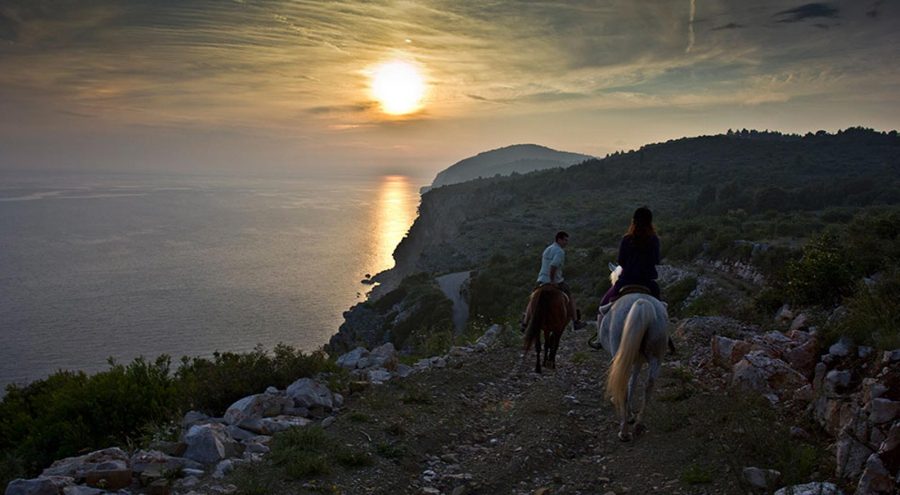
Konavle, located 30 kilometers (18.6 miles) south of Dubrovnik, is a rural region known for its vineyards, forests, and coastline. It offers outdoor activities such as horseback riding, ATV-Quad safaris, and buggy tours, all organized by Kojan Koral in the village of Radocici. The area is easily accessible by road from Dubrovnik, with transfers included in most tour prices.
Horseback riding tours cover 11 kilometers and last about two hours. They follow forest and coastal trails and are suitable for beginners. Each tour includes wine, snacks, and transfer. ATV-Quad safaris run for 2.5 hours through swamps, rivers, and hills, with fresh fruit served after the ride. Buggy safaris offer a 4-hour tour, including a 2-hour ride through rivers, plains, vineyards, and villages.
Prices vary: horseback riding starts at €120 ($140, £103) per person; ATV-Quad safaris cost €130 ($154, £111) for shared quads or €180 ($213, £154) for solo riders, buggy tours cost €90 ($106, £77) per person. All tours start with a safety briefing and can be booked online. These activities are suitable for all ages and offer a way to explore the countryside outside Dubrovnik.
15. Zipline

Ziplining in Dubrovnik offers three main options for visitors: Panorama Zipline, and Skybike Zipline on Mount Srđ and DU the Wire in Dubac, 4 kilometers (2.5 miles) south of the city. Panorama Zipline provides two rides on dual cables above the Old Town, with clear views of the city and Adriatic Sea. Skybike, an elevated cycling experience on suspended wires, takes riders across a single cable in a seated bike-like harness. DU the Wire features a 900-meter-long line, positioned at 175 meters altitude, and reaches speeds of up to 100 km/h in a superman-style position. The route crosses over cliffs, forest, and coastline.
Panorama Zipline costs €55 ($65, £47) per person and includes transport to and from the site. Tickets are available online. Skybike offers rides for €35 ($41, £30). DU the Wire costs €60 ($71, £52) per person, and online tickets are also available. Both experiences include all necessary gear and safety instruction.
Panorama Zipline and Skybike are accessible via the Dubrovnik cable car or by car to Mount Srđ. DU the Wire can be reached by a short drive, a public bus no. 10, or taxi from central Dubrovnik. Ziplining in Dubrovnik is a practical half-day activity for visitors looking for outdoor adventure and views beyond the Old Town.

16. Rock climbing
Rock climbing in Dubrovnik is available at the Brgat crag, a limestone climbing site located approximately 6 kilometers (3.7 miles) from Dubrovnik’s Old Town, about 10 minutes by car. The area offers 21 bolted sport climbing routes ranging from 9 to 15 meters in height and graded from 4a to 7b, suitable for both beginners and intermediate climbers.
Brgat is equipped with solid anchors and becomes naturally shaded after 4 p.m., making it suitable for afternoon climbs. Most visitors spend 2 to 4 hours at the site. Early morning and late afternoon are the best times to climb due to cooler temperatures and better visibility.
Climbers need to bring their own gear, including shoes, harness, rope, and helmet. Guided tours are available and typically include transportation, equipment, and instruction. A standard half-day rock climbing trip costs around €115 ($135, £99).
Brgat is a practical option for visitors interested in sport climbing near Dubrovnik, offering a range of routes in a convenient and accessible location just minutes from the city center.
17. Go Wine Tasting Near Dubrovnik, Croatia
Discover wine tasting near Dubrovnik for an idyllic mix of flavor and scenery. Within reach are three distinct wine regions: Konavle Valley, Pelješac Peninsula, and Komarna, each offering its own signature wines and breathtaking landscapes.
Konavle Valley, 20 km (12 miles) south, is renowned for the crisp white Malvasija Dubrovačka. Small family-run estates like Karaman Winery near the vineyards welcome visitors for tastings and vineyard walks. About 30 km (18 miles) north lies the Pelješac Peninsula, where the powerful red Plavac Mali thrives in vineyards producing celebrated wines like Dingač and Postup, with tastings available at Miloš Winery and Saints Hills Winery. Further afield in Komarna, Croatia’s youngest wine region, Rizman Winery stands out. Named the most beautiful winery in Europe in a recent study of 500 top vineyards conducted by the international ferry company DFDS, Rizman features organic vineyards overlooking the Pelješac Bridge and Adriatic Sea.
In Dubrovnik, visitors can sample Croatian wines by the glass at Wine Bar D’Vino and M’arden in the Old Town or visit Škar Winery near the Lapad marina, the only winery within city limits. These are good options for those not leaving the city.
Wine tastings at local bars range from €7 ($8.30, £6) for a glass up to €60 ($70.70, £51.50) for tasting of four wines with food pairing. Winery visits typically cost between €25 ($29, £21) and €45 ($53, £39), while organized tours with transport and multiple stops cost €80 ($94, £69) to €150 ($177, £129) per person. Most vineyards are best reached by car or as part of a guided tour, as public transport is limited.
Recommended Wine Tours include:
18. Tour the brewery

A brewery tour at Dubrovnik Beer Company offers a straightforward way to experience local craft beer. The brewery is located in a former salt storage facility in the port of Gruž, 3.5 kilometers (2.2 miles) from Dubrovnik’s Old Town. It produces four core beers: Maestral, Goa, Fortunal, and Grego, and operates a taproom open daily from February through December.
Tours run daily at 6 and 7 p.m. from February to October and include a 40-minute walkthrough of the brewing area, followed by a tasting of all four beers accompanied with a burger. The taproom provides additional space for sampling and is often visited by locals as well.
The tour costs €55 ($65, £48) per person and includes the guided tour, beer tasting, and snacks. Visitors can reach the brewery by taxi, local bus, or a 30-minute walk from the city center. Booking in advance is recommended, especially during peak months.
19. Chill at Dubrovnik’s coolest bars

Chilling at Dubrovnik’s coolest bars is a great way to enjoy the city’s atmosphere, sea views, and nightlife. The Buza Bar I and Buza Bar II, located on the outer side of the Old Town walls, are two of the most unique options. These bars are accessed through small stone passages in the wall and sit on narrow cement terraces above the sea. They’re basic in setup: plastic chairs, cash-only service, and expensive drinks, but the location and sunset views make them popular spots.
The Cave Bar More, set inside a natural cave below Hotel More in Lapad, is another standout. It offers indoor cave seating and a terrace with sea views. In the Boninovo neighborhood along the road to Pile Gate, Fratellos Prosecco Bar delivers a refined experience with stylish decor, curated prosecco selections, tapas, and panoramic views of the Adriatic.
Buza I and II are within the Old Town. Cave Bar More is 4 kilometers (2.5 miles) from the center and reachable by taxi or local bus in 10–15 minutes. Fratellos is in a Boninovo neighborghood, 10-minute walk from the Old Town.
Drink prices range from €7 ($8.20, £6) for a glass of wine to €12 ($14, £10.40) and up for cocktails.
20. Chase The Views

Searching for the best views over Dubrovnik’s Old Town, red rooftops, and the Adriatic Sea is a top activity for visitors. Several locations in and around Dubrovnik offer panoramic vantage points perfect for photography, sightseeing, or simply taking in the landscape.
The City Walls provide elevated views of the Old Town’s streets and rooftops, and are ideal for wide shots and architectural details. Just beyond Pile Gate, Gradac Park offers views of Fort Lovrijenac from its nearby parking area. Park Orsula, accessed via Vlaho Bukovac Street, gives a broad view of the Old Town and is best in the early evening. Mount Srđ, accessible by cable car, foot, or car, offers the city’s highest viewpoint and is especially popular at sunset.
Entry to the City Walls costs approximately €40 ($46, £34). A round trip cable car ticket to Mount Srđ costs about €27 ($32, £23). Gradac Park and Park Orsula are free to access.
Several restaurants also offer good views. Stara Loza’s rooftop terrace overlooks the Old Town, while Prora Restaurant at Hotel Excelsior faces the sea. These options are suitable for those wanting scenic views without walking or climbing.
All locations are within walking distance or a short drive from the Old Town. Visitors should wear comfortable shoes and check light conditions for photography.
21. People Watch

People-watching in Dubrovnik is best enjoyed at the Old Port, located on the eastern edge of the Old Town. Built in the 15th century and completed in the 16th, the port remains an active part of city life. It offers a steady flow of locals, tourists, boats, and kayaks, making it an ideal spot to observe daily activity.
Visitors can sit along the stone benches, walk the Porporela breakwater, or stop at a nearby café. The area provides clear views of Lokrum Island and frequent street performers. The Old Port is free to access and within easy walking distance of any point in the Old Town.
There is no entry fee or set schedule, visitors can stop by briefly or stay for hours. The best time to visit is late afternoon or early evening, when the lighting is better and the crowds are more relaxed. The Old Port is suited for anyone wanting to pause, watch, and absorb the atmosphere of Dubrovnik.
22. Have An Ice Cream
Having an ice cream in Dubrovnik is a simple and popular way to cool off, especially during summer. Ice cream shops are found throughout the Old Town, making it easy to stop for a quick refreshment while sightseeing. One of the best-known spots is Dolce Vita, located just off Stradun. It offers 28 flavors of ice cream, homemade cakes, and crêpes with various toppings. The shop is frequented by both tourists and locals.
Other top options include Gianni, known for its high-quality gelato and seasonal flavors, and aRoma Gelato, the most expensive of all, focusing on traditional Italian-style ice cream made with local ingredients. All three locations are within walking distance of major attractions in the Old Town.
Prices for ice cream typically start at €2.50 ($2.90, £2.20) for a scoop, but they go as high as €4 ($4.70, £3.50) per scoop.
23. Visit Trsteno Arboretum
This beautiful botanical garden dates back to the late 15th century. Ship captains brought various plants from their worldwide travels and planted them in Trsteno Arboretum.
Protected as a monument of landscape architecture, Trsteno Arboretum is a peaceful oasis just 20 km north of the old town of Dubrovnik.
You can spend a couple of hours walking through the gardens and enjoying the views.
Trsteno Arboretum also served as a filming location for HBO’s Games of Thrones. It doubled as Red Keep Palace gardens in King’s Landing.
You can reach Trsteno by local bus on your own, or you can visit Arboretum as a part of the Game of Thrones walking tour.
24. Visit Konavle Valley and Cavtat
Despite a great number of visitors that visit Dubrovnik every year, Konavle valley manages to remain an authentic and peaceful place away from the crowds, yet only a 30-minute drive from the old town of Dubrovnik.
Here you’ll find quaint villages, beautiful nature, traditional architecture (pay attention to interesting conical chimneys!), good local restaurants, and wine and olive oil producers.
Konavle is also famed for its embroidery. It can only be made of local silk that has been produced in Konavle for centuries. You can actually buy some of it in Dubrovnik from a local lady – Kate who sells and demonstrates traditional Konavle embroidery on the stairs near Dominican Monastery.
25. Take A Day trip from Dubrovnik
Dubrovnik’s main attractions can all be seen within two days, even within a day if you are pressed with time. However, if you are staying in Dubrovnik for more than two days, Dubrovnik is a great base to make day trips to the surrounding areas.
A visit to Mostar in Bosnia, and Kotor in Montenegro are two single most popular day trips from Dubrovnik.
If you like sandy beaches, hiking, swimming, and getting away from hustle and bustle of Dubrovnik for a day, or if you look for a really good restaurant in the vicinity of Dubrovnik, then visit Elafiti Islands for a day!
Those searching for off-the-beaten-path destinations love visiting the Peljesac peninsula on a day trip from Dubrovnik.
Birthplace of Marco Polo, Grk, and Posip wines, yummy food, and secluded beaches, Korcula Island is a must-do excursion from Dubrovnik.
Dubbed Croatia’s greenest island, Mljet Island is a great place to visit from Dubrovnik if you enjoy nature.
Neretva Valley is a beautiful part of Croatia, with its rugged hills, olive groves, mandarin orchards, rivers, channels, and large Neretva River estuary.
Mostar and Kravica Waterfalls
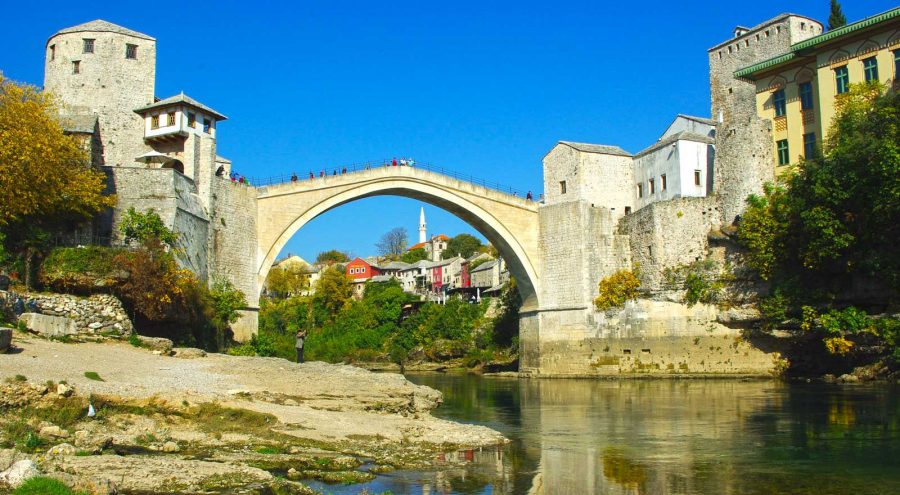
We love visiting Mostar. The old town is small but nicely preserved. It’s full of history, interesting ottoman architecture, mosques, oriental stores, and lovely restaurants, many with river views. The central point of the old town is the old bridge, a UNESCO World Heritage Site.
Mostar is 150 km far from Dubrovnik, so a one-day visit to the town is still doable. You should take a whole day for this trip. While 150 km isn’t that far, bear in mind that you can have some waiting time at the border in Metkovic when entering and exiting Bosnia and Herzegovina. Border controls are even more enforced since Croatian joined Schengen.
Due to the distances, and multiple border crossings, actually the best way to visit Mostar from Dubrovnik is on a guided coach tour.
Kotor, Montenegro

If you stay in Dubrovnik for a couple of days, visit Montenegro. Kotor town and Kotor Bay are within easy reach from Dubrovnik, and well worth a visit.
The walled old town of Kotor is full of history, and lovely medieval architecture, including churches, palaces, narrow cobbled streets, lively town squares, and cozy cafes.
You can also consider visiting Budva, the most popular seaside resort in Montenegro, and Lovcen National Park.
You can easily visit Montenegro on your own. However, if you don’t fancy driving in a foreign country, through the narrow and winding roads, plus you are budget-minded, you might consider booking this GROUP TOUR TO MONTENEGRO.
Cruise Elafiti Islands

Elafiti is a small archipelago off the coast of Dubrovnik. The archipelago consists of several islands, but only three of them are inhabited: Kolocep, Lopud, and Sipan.
If you like sandy beaches, hiking, swimming, and getting away from hustle and bustle of Dubrovnik for a day, or if you look for a really good restaurant in the vicinity of Dubrovnik, then visit Elafiti Islands for a day!
Kolocep’s Villa Ruza, the restaurant Obala on the island of Lopud, and BOWA on Sipan Island are all great restaurants to have a meal at by the sea.
A private speedboat tour of the islands is the best way to explore the Elafiti. We did that back in 2014!
Otherwise, check these two boat tours to Elafiti Islands: Elafiti Islands Day Trip with Lunch from Dubrovnik, and Elafiti Islands Day Cruise on a Karaka Ship.
You can also visit Elafiti on a ferry from the port of Gruz.
Peljesac Peninsula

Those searching for off-the-beaten-path destinations love visiting the Peljesac peninsula on a day trip from Dubrovnik. This region is one of our favorite parts of Croatia. It still remains under the radar of many tourists, despite its vicinity to Dubrovnik, its famed red wines, wonderful beaches, and serving as the main gateway to Mljet and Korcula islands.
If you wish to visit Peljesac from Dubrovnik on your own, you’ll need a car (you can rent one for a day here). Plan a full day for this visit, and two days would even be better.
However, if you are short on time, or prefer not to drink and drive, look into this small-group tour of Peljesac & Korcula.
Korcula Island
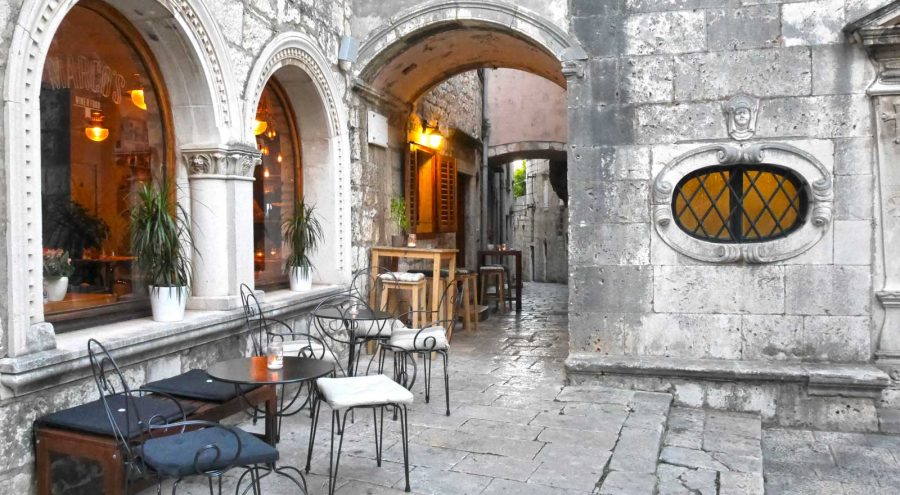
Birthplace of Marco Polo, Grk, and Posip wines, yummy food, and secluded beaches, Korcula Island is a must-do excursion from Dubrovnik. Korcula Island is easily accessible from Dubrovnik.
Medieval architecture, laid-back vibe, beautiful nature, hidden beaches and coves, great food, and great wines, make Korcula Island one of the most popular, and most visited Croatian islands.
If you stay in Dubrovnik for more than two days, don’t miss Korcula!
You can reach Korcula from Dubrovnik on a catamaran (June, July, and August), by car through the Peljesac peninsula, and then by taking a car ferry or a passenger boat across to Korcula.
But, the stress-free way to visit Korcula from Dubrovnik is on a guided group tour from Dubrovnik.
Mljet National Park

Dubbed Croatia’s greenest island, Mljet Island is one of the great places to visit from Dubrovnik if you enjoy nature. Mljet is a small, and quiet island in southern Dalmatia. Mljet’s main attraction is the national park of the same name that covers the northeastern part of the island.
Admission to the national park is 20 € per adult from June through September, and 10 € in other periods (5 € discount if purchased in advance via Park’s website). The boat ride will set you back an additional 5 € per person (return ticket). You can also rent bicycles in the park (not included in the ticket price). Hiking and swimming are popular activities in the park.
You can reach Mljet from Dubrovnik on a catamaran (July, and August), by car ferry from Prapratno on Peljesac to Sobra on Mljet Island, or by booking a group tour through tour agencies.
Neretva River Safari

Vera comes from Neretva Valley, and we absolutely love this region. It’s underrated, undiscovered, mostly agricultural, and very little touristy. Yet, Neretva Valley is a beautiful part of Croatia, with its rugged hills, olive groves, mandarin orchards, rivers, channels, and large Neretva River estuary.
The area is famed among kite surfers and bird watchers. It’s also popular for its distinctive regional food including frogs, and eels.
You can explore Neretva valley on a traditional boat. Many local restaurants offer a boat ride and even serve a meal aboard a boat. Restaurant Neretvanska kuca is one of such places.
What Are The Free things to do in Dubrovnik?
Dubrovnik offers several free activities that allow visitors to enjoy the city’s history, culture, and natural beauty without spending money. Walking through the Old Town is free and gives access to its narrow stone streets, historic buildings, and landmarks like Onofrio’s Fountain and Luža Square. The Sponza Palace atrium, known for its Gothic-Renaissance architecture, is also open to the public at no cost. For sea views, visitors can head to the Old Port or walk along Porporela, the pier behind St. John’s Fortress, which is especially scenic at sunset.
Nature lovers can climb Mount Srđ on foot, following a marked trail that starts above the city and leads to the summit for panoramic views of Dubrovnik and the Adriatic. Swimming and beach hopping is another free way to enjoy the coast, with spots like Šulić Beach and Danče Beach located within walking distance of the Old Town. Art enthusiasts can explore small galleries such as Art by Stjepko, which features local works of Stjepko Mamic, the owner, and is free to browse. You might end up buying some of his beautiful vibrant paintings of fish and the underwater world. Churches like St. Blaise’s Church and markets like Gundulić Square also offer free cultural experiences.
We love taking a small detour when driving down to Dubrovnik. In the village of Slano, we climb up the hill, to the old road built in the time of Napoleon. The road is narrow but asphalted throughout. It goes from Slano to Trsteno. It takes you up the hill where views over the sea and surrounding islands are spectacular.
What To Do In Dubrovnik With Children?
Dubrovnik offers a range of family-friendly activities that engage children of all ages. Walking the City Walls provides an active and scenic experience, with towers to climb and sweeping views of the Old Town and sea. A short ferry ride brings families to Lokrum Island, where children explore forest paths, swim in the Dead Sea lagoon, and watch peacocks roam freely.
For beach time, Lapad Beach offers the best setup for children, with a long pedestrian promenade, shallow waters, shaded play areas, and nearby cafés and ice cream stands. It’s well-suited for families looking to spend several hours by the sea.
The Dubrovnik Aquarium, located inside St. John’s Fortress, features local marine life in an easy-to-navigate space. The Dubrovnik Puzzle Punks Escape Room offers themed adventures that involve teamwork and problem-solving, ideal for older children and teens. Outside the city, Cadmos Village Adventure Park in Konavle provides ziplining, obstacle courses, and paintball, while nearby Kojan Koral offers horseback riding through forest trails.
Water-based activities such as sea kayaking around the city walls and snorkeling near coastal coves add variety for older kids. Stops for ice cream at Dolce Vita or Gianni offer an easy reward between sights. A ride on the cable car to Mount Srđ rounds out the day with panoramic views and space to move around at the top.
All activities are accessible by foot or short rides.
Further reading
- Start planning your travel to Dubrovnik with our Dubrovnik Travel Guide.
- Find where to stay in Dubrovnik with our Dubrovnik accommodation guide.
- Find out the best Dubrovnik beaches here.
- Where to eat in Dubrovnik: our guide to the best restaurants in Dubrovnik
- Things to do in Dubrovnik beyond the city walls
- 14 Day Trips From Dubrovnik
- Best time to visit Dubrovnik
- A wine-tasting tour of Dubrovnik
- Exploring Dubrovnik’s surroundings, the Sokol Grad Tower
- Elafiti islands, island hopping around Dubrovnik archipelago
- Planning to travel to Split? Here is our guide on how to get from Dubrovnik to Split.
- Split or Dubrovnik: Where to go first?
We hope you’ve enjoyed our post on top things to do in Dubrovnik. As always, if you have any questions, comments, or suggestions, please leave them in the comments below.

Thanks for the information though, I just created a list of top 10 things to do in Mljet, Croatia for my next of trip and I think I am certainly going to do all that stuff and enjoy a lot. Wish me good luck.
I’m looking at booking a tour to Croatia starting on March 12th, 2020. It’s obviously cheaper because it’s off season. Will I be disappointed because of cold weather and no leaves on the trees, etc?
Hi guys, thanks for stopping by. Yes, GOT tours are still worth doing as that’s just another way to see major city’s landmarks.
Oh my, I could read this for a week there is so much awesome information to take in. We are staying for a week right outside of Dubrovnik and trying to fill our calendar up and get the most out of the time there.
We definitely plan to do some Kayaking and a boat trip. The GOT tours would be great, but are they worth the money? I myself am a fan but my partner isn’t quite as interested in the show as myself. Would it still be worth doing the tours?
Thanks in advance..
Dom and Jo
Having visited Dubrovnik in July 2018 during a 1 week cruise, I found myself in the uncomfortable role of grateful and respectful admirer in theory and worst display of mindless mass tourism that should have no place in this natural and architectural marvel.
The whole old town becomes unlivable all morning and the beautiful square just outside the old walls that has a spectacular view on the far end becomes a human parking lot with thousands of people made stand there queuing for ever.
I really have no idea why the municipality allows this insanity to continue, the city is booming with quality tourism anyway. I just hope that soon enough this nonsense will be stopped.
thanks for the correction Vanessa
Have fun!
This site is absolutely fantastic, i’m off to Croatia on Saturday and I now have loads of info and trips to book! Thank you
Hi! Thanks for the great suggestions. FYI Mount Srd is 412 metres (1,352 ft), not 778m as indicated in your post :) Only noticed this as I’m writing an article myself on Dubrovnik and looked to your post as inspiration!
-Vanessa
This is such a great list, thanks so much. My family and I, 7 people total will be in Croatia for 5 nights, 6 days. We have a trip to MonteNegro already booked. We are staying in an apartment. My question: how much Kronor should we get at the airport, and is the airport the best place to exchange money? Are there other places to exchange American dollars for Kronor? Can we use an ATM? thanks!
Great to hear that, Joanne! And really happy that you’ve enjoyed Croatia!
Thanks Frank. We’ve just spent 10 nights in Croatia – plitvice, zadar, split and Dubrovnik. It’s our first time in Croatia, and found your site invaluable!
Thanks for all the information. We were already really looking forward to visiting Dubrovnik next week, now we’ve got loads more ideas of things to do and things to see.
You have saved me weeks of research. I so value all of this information and your suggestions (especially tourist vs local options). Thank you!
Hi Kate,
glad you find the website useful. Did you check our post on things to do in Split: https://www.frankaboutcroatia.com/top-things-to-do-in-split-croatia/ ? Many activities are listed there. Sea kayaking, a visit to Blue Lagoon, islands hopping, and Cetina rafting or zip-lining are all great.
Your website is fab I have been browsing for hours! Me and a friend are traveling to Split and Dubrovnik at the end of July beginning of August we have already booked excursions in Dubrovnik but would like your top recommendation for a day trip while in split? Thanks
Thanks, Tom! Glad I could help. Have a nice time in Croatia!
Sir, your website is quite a wealth of information. Thank you for spending so much time on it. It has made my planning for our trip to Croatia much easier and more fulfilling.
This is the most detailed guide for Dubrovnik I have seen, Frank! Thanks for the efforts.
The cable car looks spectacular. There’s a wonderful one in Yeosu, Korea, where I live, too, but I think it probably pales in comparison to Dubrovnik’s. I can’t wait to venture to Croatia. It’a a place that was always somehow evaded my travel plans. I will, however, be rectifying that soon. Enjoy the rest of your day.